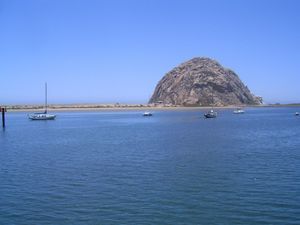Advertisement
Published: August 6th 2007

 Morro Bay
Morro Bay
A view of the rockI graduated with my BA in Anthropology in June of this year. I decided that I would try out life as a field technician for a while. Field techs are usually hired by CRM (Cultural Resource Management) firms for specific lengths of time, from a few weeks to a few months, to work on specific projects. We are often required to work away from home and in other states because opportunities in the cities where we live can be few and far between. As a result, field techs are usually offered an hourly rate and per diem (an allowance for food and lodging). I heard about a job opportunity in California through a friend of mine that I met in field school, and she knew the archaeologist in charge, so I decided to apply. The pay was really good, and I have always been comfortable in California, so I thought it would be ideal as a first assignment.
I stayed in Morro Bay, which is north of San Luis Obispo. It's a tiny, historic fishing village that has a curious looking volcanic rock right off of its shore. The main street runs along the shoreline, and is filled with shops
and restaurants that were just a short walk from my hotel. I couldn't have picked a better place to stay.
The Carrizo Plain
The place where we were surveying was a different matter, however! During a survey, archaeologists line up in a row and stand 10-30 meters apart, then walk in a straight line, looking for artifacts on the ground as you go. We were surveying 4000+ acres of ranch land on the Carrizo Plain, which is dry, desolate, and hot. Apparently the breeze from the coast does not make it over the mountains onto the Carrizo Plain! Dry, plowed dirt can be really hard to walk on, so I quickly developed huge blisters on my feet. I also discovered that I am more suceptible to heat exhaustion than I had previously thought. At the end of the first day, I ended up getting sick on the car ride home. A combination of overheating, a bad headache, and the winding road. It took some time to figure out how I should be pace myself. It was hard to admit that I could not keep up with the others, most of whom have been doing this kind of work for

 The Carrizo Plain
The Carrizo Plain
Dry, desolate, hot-- no artifacts!years. Fresh out of a career in banking, I was not as conditioned to walk 8-10 miles a day in the heat as they were. One of the first humiliating lessons of a shovelbum-- stay in shape!
After a few lessons in heat exhaustion prevention and first aid (the blisters, remember), I felt better. Our work was cut in half because the company who needed the survey did not purchase all of the land they originally planned. For the last three days of the survey, we recorded a historic farm site that was on the property. Recording a site just means that you list all of the features in the site and draw them to scale on graph paper. For example, one of the features was a trash pile, so each major item (old washer, sink. etc) in the pile had to be measured, mapped, and annotated. This was good experience for me since I plan to go into historical archaeology.
We did not find any artifacts during the 6 days of pedestrian survey. I also managed to get a bad case of strep throat while I was out there. But I stuck it out, and in spite

 The Carrizo Plain
The Carrizo Plain
That's the San Andreas fault line in the distanceof all the difficulties I
loved being out there doing survey, getting my hands dirty, and being outside. If I can tough it out on the Carrizo Plain and still enjoy what I was doing, then I guess that means that this profession really is for me...
Advertisement
Tot: 0.111s; Tpl: 0.009s; cc: 12; qc: 57; dbt: 0.061s; 1; m:domysql w:travelblog (10.17.0.13); sld: 1;
; mem: 1.1mb

 Morro Bay
Morro Bay
 The Carrizo Plain
The Carrizo Plain
 The Carrizo Plain
The Carrizo Plain